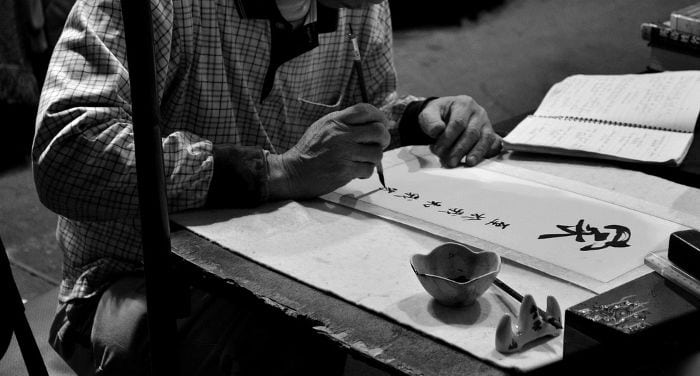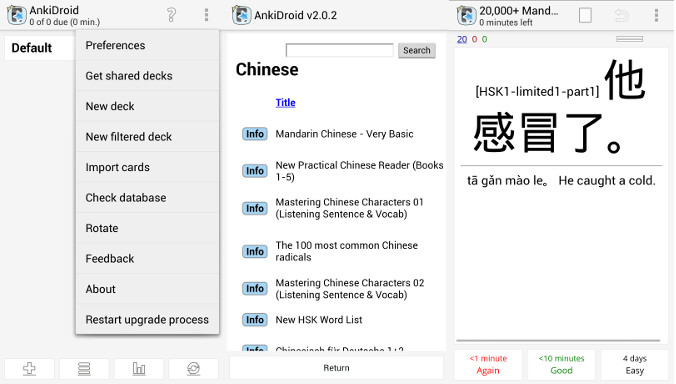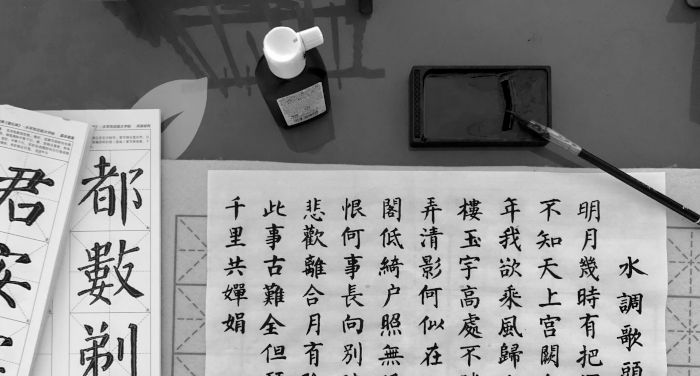
In this article we’ll discuss the doubling of verbs, nouns and classifiers, are one of the most evident and common peculiarities of Chinese grammar. Besides, who’s never said “一点点 (yī̠diạ̌ndiǎn)”?
Let’s start with classifiers to then move on to nouns, verbs and predicative adjectives.
The doubling of classifiers
The classifiers, which we’ve already covered in a preceding article, can be doubled according to precise rules. Doubling classifiers is divided into three “types”.
The simple doubling of classifiers
The first type of doubling we’ll consider is simple doubling, which is made up of a classifier followed by a classifier:
Classifier – Classifier
The simple doubling of classifiers accentuates the collective value of a noun. This doubling always appears in the segment of the phrase that precedes the verb. Usually, classifiers doubled in this way are covered by the adverb 都 (dōu), which means “all”.
Let’s look at a few examples:
家 (jiā): classifier for buildings
这里的家家饭馆都非常漂亮。
Zhèlǐ de jiā jiā fànguǎn dōu fēicháng piàoliang.
Every restaurant in this area is very beautiful.
个 (ge): generic classifier
那座山上的个个羊都很胖。
Nà zuò shān shàng de gègè yáng dōu hěn pàng.
All sheep on that mountain are fat.
在那家学校学习的个个学生他都认识。
Zài nà jiā xuéxiào xuéxí de gègè xuésheng tā dōu rènshi.
He knows every student that goes to that school.
间 (jiān): classifier for rooms
间间屋子他都打扫了。
Jiān jiān wūzi tā dōu dạ̌sǎo le.
He cleaned all the rooms.
本 (běn): classifier for items that can be flipped through
鲁迅写的本本小说他都看过。
Lǔ Xùn xiě de běn běn xiǎoshuō tā dōu kànguo.
He read all the novels that were written by Lu Xun.
The complex 1 doubling of classifiers
The second type of doubling that we will present is complex number 1:
Number – Classifier – Number – Classifier
or
Number – Classifier – Classifier
The complex 1 doubling of classifiers has a distributive function. When using the first formula, classifiers tend to be followed by the particle 的 (de) if it comes after a name; if instead it comes after a verb, the classifiers will be followed by the particle 地 (de).
When using the second formula, classifiers will not be followed by 的 nor 地; but rather by the adverb 都, which might also be admitted.
Let’s see some examples:
桌子上放着一张一张的照片。
Zhuōzi shàng fàngzhe yī zhāng yī zhāng de zhàopiàn.
The photos are arranged one by one on the table.
学生的汉语水平一步一步地提高了。
Xuésheng de Hànyǔ shuǐpíng yībùyībù de tígāo le.
The students’ level of Chinese, step by step, has improved.
学生一个一个地进入教室了
Xuésheng yī gè yī gè de jìnrù jiàoshì le.
The students entered into the classroom one by one.
《哈利波特》的小说,我一本本都看过。
《Hā lì bōtè》 de xiǎoshuō, wǒ yī běnběn dōu kànguo.
I read all the Harry Potter novels one by one.
天一点点黑了。
Tiān yī̠diạ̌ndiǎn hēi le.
Little by little it got dark.
The complex 2 doubling of classifiers
To conclude, let’s see the complex 2 doubling of classifiers:
Number – Classifier – Name – Number – Classifier – Name
The complex 2 doubling accentuates the distributive value of classifiers. This doubling is usually found before the verbs and are followed by the particle 地.
Let’s see some examples:
你应该一个词一个词地翻译。
Nǐ yīnggāi yī gè cí yī gè cí de fānyì.
You need to translate word for word.
你必须一个汉字一个汉字地背下来那首诗。
Nǐ bìxū yī gè Hànzì yī gè hànzì dì bèi xiàlai nà shǒu shī.
You have to memorize that poem character by character.
To accentuate the distributive value of the classifiers you can also use this structure:
Number – Classifier – 又 (yòu) / 比 (bǐ) – Number – Classifier
Here are some examples:
为了学会中文,我们要一偏比一偏地写汉字。
Wèile xuéhuì Zhōngwén, wǒmen yào yīpiān bǐ yīpiān de xiě hànzì.
To learn Chinese, we have to write characters root by root.
问题一个又一个地解决了
Wèntí yī ge yòu yī ge de jiějué le.
One after another, the problems were solved.
“每 (měi) … 都 (dōu) …”
Note that the construction “每 (měi) … 都 (dōu) …” has the same value of the simple doubling, or has the generalized function of “every… / all…”
每 is always followed by the classifier, except when the noun that follows is among those that don’t require a classifier (like “day” for example).
Here are some examples:
这里的每个学生都很努力。
Zhèlǐ de měi ge xuésheng dōu hěn nǔlì.
All the students from here work hard.
这些衣服每件都很漂亮。
Zhèxiē yīfu měi jiàn dōu hěn piàoliang.
These dresses are all very beautiful.
那里的每家饭店都去过。
Nàli de měi jiā fàndiàn dōu qùguo.
I went to every restaurant in this area.
我每天都学中文。
Wǒ měitiān dōu xué Zhōngwén.
I study Chinese every day.
每年我的朋友们到中国去。
Měi nián wǒ de péngyou men dào Zhōngguó qù.
Every year my friends go to China.
The doubling of nouns
There are words that don’t allow a classifier after it. The most common are: 天 (tiān) “day”; 年 (nián) “year”; 分钟 (fēnzhōng) “minute”; 页 (yè) “page”.
These names can be doubled using the simple doubling and therefore express the meaning of “every / all / each” which is usually obtained through doubled classifiers.
Basically, the doubling of nouns that don’t require the use of classifiers can be done when monosyllable nouns makes sense if doubled.
For example, 人 (rén) “person” and 次 (cí) “time” can be doubled so that its meaning is “every person” and “every time”, 人人 and 次次 respectively. Here’s an example:
学生天天都来上课。
Xuésheng tiāntiān dōu lái shàngkè.
The students come to the lesson every day.
The doubling of verbs
Even verbs can be doubled in Chinese. When doubled, the intensity of the action verb diminishes.
The doubling of the verbs is used in the spoken language, with a casual and light tone, so much so that in the majority of cases, the double verb presents a neutral tone.
When the verb that we want to double is monosyllabic, we can adopt the rule:
Verb + Verb
吃吃 (chīchī), which means “to eat”, and when doubled becomes: “taste / taste a little / have a bite.
Verb + Number 1 + Verb
吃一吃 (chī yī chī) (the meaning doesn’t change).
Here are some other examples:
问问 / 问一问。
Wènwen / wèn yī wèn.
Try to ask a little.
试试 / 试一试。
Shìshi / shìyīshì.
Go on, try a little / try it.
听听 / 听一听。
Tīngting / tīng yī tīng.
Listen a little.
When we want to double a verb in the past, we need to insert the perfect particle 了 (le) between the two verbs, in place of number one 一 (yī).
When the verb that we want to double has more than one syllable, we can use one of the two following rules:
Verb (Character 1 + Character 2) + Verb (Character 1 + Character 2)
讨论讨论。
Tǎolùn tǎolùn.
Talk it over a little.
批评批评。
Pīpíng pīpíng.
Criticize a little.
考虑考虑。
Kǎolǜ kǎolǜ.
Reflect a little.
Or:
Verb (Character 1 + Character 1 + Character 2)
睡睡觉。
Shuì shuìjiào.
Take a nap.
洗洗澡。
Xǐ xǐzǎo.
Give it a wash.
The doubling of predicative adjectives
Contrary to what takes place with verbs, when doubling predicative adjectives you get an accentuation of their value.
Here are some examples:
红红的花。
Hónghóng de huā.
Intense red flowers.
圆圆的莲花。
Yuányuán de liánhuā.
Perfectly round lotus flowers.
长长的头发。
Chǎngcháng de tóufa.
Really long hair.
小小的嘴。
Xiạ̌oxiǎo de zuǐ.
Very small mouth.
There are only a few predicative adjectives with more than one syllable that allow for doubling. These are doubled with the AABB formula and are listed below:
高兴 (gāoxìng) “happy, content”
高高兴兴 (gāogāo xìngxìng) “very happy”
痛快 (tòngkuai) “joyful, cheerful”
痛痛快快 (tòngtong kuàikuài) “allegrissimo”
漂亮 (piàoliang) “beautiful, noteworthy”
漂漂亮亮 (piàopiào liàngliàng) “very beautiful”
干净 (gānjìng) “clean, orderly”
干干净净 (gāngān jìngjìng) “very clean”
整齐 (zhěngqí) “orderly, in place”
整整齐齐 (zhěngzhěngqíqí) “very orderly”
认真 (rènzhēn) “serious, diligent”
认认真真 (rènrèn zhēnzhēn) “very diligent”
顺利 (shùnlì) “smooth”
顺顺利利 (shùnshùn lìlì) “really smooth”
清楚 (qīngchu) “clear, distinct”
清清楚楚 (qīngqing chụ̌chǔ) “very clear”
简单 (jiǎndān) “easy, simple”
简简单单 (jiǎnjiǎn dāndān) “very simple”
热闹 (rènao) “chaotic, noisy”
热热闹闹 (rère nàonào) “really noisy”
舒服 (shūfu) “comfortable”
舒舒服服 (shūshu fufu) “very comfortable”
快乐 (kuàilè) “happy, cheerful”
快快乐乐 (kuàikuài lèlè) “very happy”
Doubled adjectives can be used as adverbs followed by the particle 地 and a verb.
Here are some examples:
慢慢地走。
Mànmàn de zǒu.
Walk very slowly.
他舒舒服服地坐在沙发上。
Tā shūshufufu de zuò zài shāfā shàng.
He’s lounging on the sofa.
她的老师仔仔细细地改正考试。
Tā de lǎoshī zǐzǐxìxì de gǎizhèng kǎoshì.
Her professor grades the tests diligiently.
Photo Credits: ![]() Chinese calligrapher by David Boté Estrada
Chinese calligrapher by David Boté Estrada



